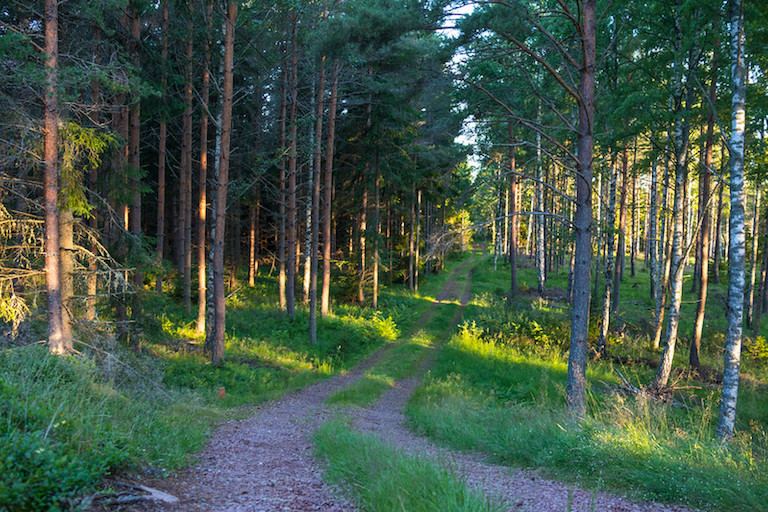- Statistical analysis of the spread of a fungal plant pathogen across a Finnish island demonstrates that roads serve as corridors for the transmission of disease in wild plants.
- According to the researchers, their data indicate that vehicles traveling along roads are directly involved in spreading diseases, not just that roadsides make good habitats for pathogens.
- The research is based on a detailed data set maintained in southern Finland’s Åland Islands, but experts say the findings could apply to other similar pathogens.
On the Åland Islands, a small, sparsely populated archipelago in southern Finland, a team of ecologists spend two weeks each autumn surveying the habitat of a particular butterfly species.
The data set has become a one-of-a-kind information-gathering effort and one of the most important models in population biology, according to Anna-Liisa Laine, a biologist at the University of Helsinki.
The Åland Islands data set also includes one critical feature: it tracks the presence of Podosphaera plantaginis, a parasitic fungus that infects the butterfly’s host plant. Yet it wasn’t until Elina Numminen visited the islands after a season of particularly diverse plant diseases that the data set turned into a case study in epidemiology. As a postdoctoral researcher in statistics at the University of Helsinki, she wanted to model it against the islands’ road system.
Leveraging statistical methods that didn’t exist 10 years ago, Numminen’s study, published in April, has shown for the first time how roads crisscrossing wilderness areas can become pathways for plant pathogens.
“This altogether surprised me,” said Numminen, who co-authored the paper with Laine. “Analysis of ecological datasets is challenging. You don’t always find results that are this illuminating and that you are this certain about.”

Pathways of transmission
Researchers, particularly those interested in maintaining healthy crops, have pegged roads and railways as corridors where pathogen hosts, such as insects, can travel between plants.
“We show for the first time, that this is not only due to roadsides being a particularly suitable habitat, but due to the roads acting as transmission pathways for the pathogen,” Numminen and Laine wrote in the paper.
As each vehicle cruises by, the paper says, it carries with it a gust of wind that sweeps up P. plantaginis spores onto nearby plants. Any plant pathogen that is similarly powdery and prone to flight would likely follow the same pattern, Numminen says.
The construction of roads across forests and meadows, the study shows, creates a new network for the transmission of pathogens as much as it does for vehicles. In the same way that the coronavirus that causes COVID-19 spreads via partnership networks like friends and co-workers, the mildew in the Åland Islands reaches more hosts as the wind from passing cars blows spores along the road.
“I think that any pathogen that disperses similarly as our powdery mildew, i.e. short distances, passively by air, could also exhibit enhanced transmission along frequently traversed roads, especially if also its host’s crop canopy is close to the surface of the ground as it was for our host plant,” Numminen wrote in an email.
“So forests, and agricultural fields, could both be threatened by such pathogens.”
In agriculture, transport corridors like roads are a “big concern” for plant health, says Neil McRoberts, who leads a team of botanists at the University of California, Berkeley, studying plant pathogens. As a result, most research in plant pathology has focused on croplands. The Åland Islands case is not only the first to reveal the impacts of roads on roadside plants, but it’s also one of the few studies in the field that has studied wild plants, says McRoberts, who was not involved in the Finnish study. The islands’ landscape is heavily influenced by humans, but the host plant, the Plantago lanceolata weed, is not agricultural.
“I think the work is very exciting,” McRoberts said. “In truth plant pathologists have paid little attention to diseases of wild plants apart from one or two groups, so this is a nice surprise.”

Looking beyond Finland
Road building has often pitted nature conservation against infrastructure growth. Roads can ease travel and promote economic growth, but they often cut through areas that are sparsely developed, encouraging deforestation and splintering wildlife habitat. After construction, roads can encourage further development into wilderness, expanding the human footprint beyond the road itself.
Pathogens that attack humans and animals have been found to spread along new roads into rural communities. In protected areas in South America, scientists have identified roads as the primary pathways for invasive species. Near China’s Yellow River, scientists found that the wind from passing traffic may have dispersed seeds and led to markedly higher levels of biodiversity by the road. In general, though, the networked impacts of roads on roadside plants remains little studied.
Obtaining a clear picture of the impact of roads on plant disease in the wild is tough. In the wild, genetic diversity is higher than in croplands, which makes modeling more complex, McRoberts said. In the Åland Islands, across 4,000 locations, Numminen was able to trace exactly when plants became infected and the proximity to roads. Numminen said she had the fortuitous opportunity to analyze this uniquely comprehensive data.
“Actually it is an amazing joint effort of [roughly] 40 biologists,” she said.
Citation:
- Numminen, E., & Laine, A. (2020). The spread of a wild plant pathogen is driven by the road network. PLOS Computational Biology,16(3). doi:10.1371/journal.pcbi.1007703
FEEDBACK: Use this form to send a message to the author of this post. If you want to post a public comment, you can do that at the bottom of the page.
